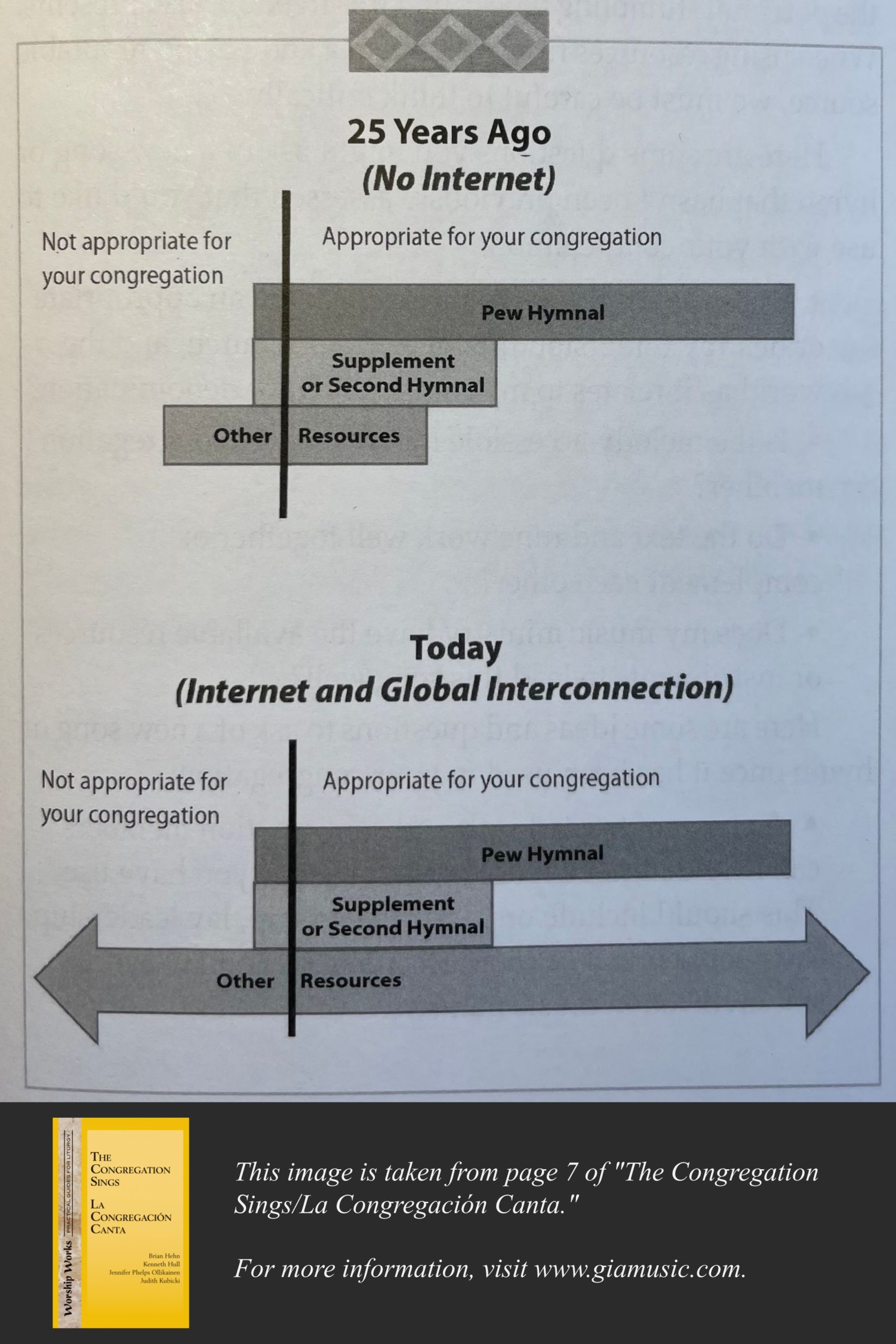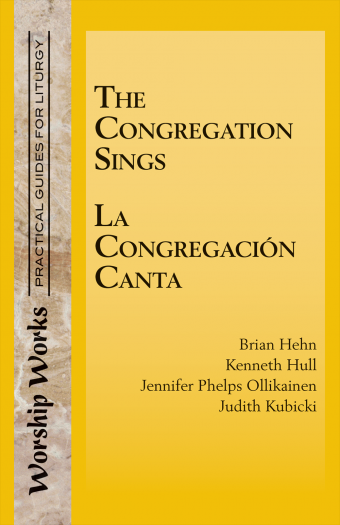Written by Brian Hehn, this article first appeared in “The Congregation Sings/La Congregación Canta,” a part of the Worship Works series. Find the full resource on our website.
As any worship planner knows, the songs and hymns we sing in today’s church are made up of lyrics and tunes that are as ancient as Moses’ song in Deuteronomy and as new as a chorus we just learned from our favorite composer’s YouTube channel. Because singing shapes our faith and affects our spirits in such meaningful ways, we know that the job of choosing song for our congregation is an important responsibility. With the rise of technology and our interconnected world, however, our job as local worship planners and church musicians has become more important than ever. We have more options for choosing our congregation’s song than ever before, making choices more abundant and more difficult. While this unprecedented access to hymns and songs is empowering and exciting, it also has huge implications for those of us who choose congregational song for worship each week.
Worship planning, then and now
Twenty or thirty years ago, the majority of congregations sang directly from one hymnal or other worship resource. What the assembly held in their hands was a collection of congregational song that was carefully put together by a group of people who pored over it for years in the selection and editorial process. During this process, a hymnal committee and editor would consider the quality of the texts, the “sing-ability” of the melody, the quality of the accompaniment, and the theology of the text. After the hymnal was published, a church would look through a number of available hymnals and decide on which one to buy for their congregation. That mean that by the time worship planners began to choose songs for liturgies, they were choosing from a carefully selected collection that multiple groups and individuals had already determined were healthy choices both musically and theologically for their congregation to sing. While choosing songs that paired well with scripture readings or liturgical moments was the job of the worship planner, the decision on whether a song was generally healthy for their congregation to sing was already made.
Fast-forward to worship planning today. While our highly scrutinized hymnals and hymnal supplements are mostly still in the pews and are often still the main resource for choosing a congregation’s song, we now have many more options. Because w print our music in a worship aid or project words and music onto screens, we are not bound to choose music solely from the pew hymnals. We could also use songs from an infinite number of sources that can be accessed quickly and easily on the Internet. Scans of countless hymns from the eighteenth and nineteenth centuries can be downloaded free of charge because they are out of copyright. There are new hymns written by aspiring poets and church musicians who post their work for free online. Collections of texts and tunes by established hymn and song writers are available through church music publishing companies. Chord charts and recordings of songs from Contemporary Christian Music (CCM) artists are easily available as a download purchase. Resources available to worship planners have expanded exponentially over the last twenty years.
More choices, more chances
We worship planners have a newfound freedom. We have more choices for finding congregational song than ever before. That means we now have a better chance of discovering a song that is a perfect fit for a specific liturgical moment. It also means, however, that we have a better chance of finding songs that are inappropriate for our congregation to sing. Here’s what I think our past and current realities as worship planners look like when choosing congregational song.

Because songs on either side of the line are now more readily and widely available, our roles have changed. Previously the roles of selection committee, editor, and worship planner were separate. Each part of the process served to evaluate songs, first by group wisdom and discernment through a selection committee, then by church music expertise and refinement through an editor, and finally by contextual expertise through a local worship planner or planning team. While the slow-paced intentional process that results in a carefully reviewed resource called a hymnal is still in place, it is now only one of the many options available to a worship planner. When a worship planner moves outside of the pew hymnal, he or she becomes the selection committee, hymnal editor, and worship planner all in one. This allows for much more flexibility and many more possibilities for our congregation to sing well, but it also increases the chances that a poor choice is made.
Thinking critically
Let me be clear. I am not advocating using hymnals to the exclusion of other resources that are now available to us. On the contrary, we must embrace the gift that our newfound interconnectedness through technology brings to the church’s song. But while we embrace the good, we must be aware of the potential stumbling blocks that this freedom also presents. When using resources from other than a known and reputable source, we must be careful to think critically.
Here are some questions you might ask of a new song or hymn that hasn’t been previously assessed that you’d like to use with your congregation.
- Does the theology of this text provide an appropriate or healthy understanding of God, the church, and the world as it relates to my congregation or denomination?
- Is the melody accessible for an average congregation member?
- Do the text and tune work well together or compliment each other?
- Does my music ministry have the available resources or instruments to lead this song well?
Here are some ideas and questions to ask of a new song or hymn once it has bene used in your congregation:
- A group of trusted staff and congregation members can help de-brief new hymns and songs you have used. This should include ordained leadership, lay leadership, lay people involved in music ministry, and lay people not involved in music ministry.
- A support group of other worship planners or church musicians who serve in a similar context as you can meet on a regular basis.
Ask questions like:
- Did the congregation sing the song well? If not, why not?
- Did the style of the song fit into your liturgy’s general aesthetic?
- Did you receive unsolicited feedback from congregation members or church leadership on the new selection? Did someone go out of their way to tell you what they thought about the new song?
- Do you think you should use this song again? If so, should you explore other songs like it to continue expanding your church’s repertoire in that direction?
This is the kind of intentionality that worship planners now need in order to nurture their congregation’s faith and spirituality fully. When choosing songs from resources outside of a reliable vetting process that we trust, it is the responsibility of the worship planner to be intentional and careful. It is more work, but it is good work. It is the critical work of a worship planner as we strive to love God and serve neighbor by way of the church’s song.

Brian Hehn
Brian serves as the Director for The Center for Congregational Song. Experienced using a variety of genres and instrumentations, he has lead worship for Baptists, Roman Catholics, United Methodists, Presbyterians, and many more across the U.S. and Canada. He received his Bachelor of Music Education from Wingate University, his Master of Sacred Music from Perkins School of Theology, Southern Methodist University, and is certified in children’s church music (K-12) by Choristers Guild. He has articles published on sacred music and congregational song in multiple journals and co-authored two books under the title “All Hands In” published by Choristers Guild. While working for The Hymn Society he also serves as adjunct professor of church music at Wingate University in Wingate, North Carolina. Brian lives in Baltimore, Maryland, with his wife, Eve, and son, Jakob.


Recent Comments